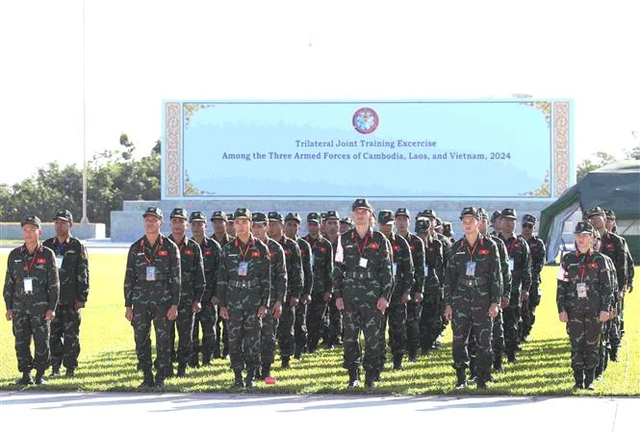Viet Nam, Laos, Cambodia hold joint search, rescue exercise
VGP - The defence ministries of Viet Nam, Laos and Cambodia on November 18 launched a joint search and rescue exercise themed "Rescue and relief activities at collapsed structures" at the Royal Gendarmerie of Cambodia Training Centre in mountainous Chum Sen Rikreay area, Kampong Chhnang province, Cambodia.

Vietnamese officers and soldiers at the exercise in Cambodia. Photo: VNA
The joint military exercise aims to strengthen cooperation and mutual support among the three nations' armed forces during natural disasters, focusing on minimizing casualties and property losses through timely civilian assistance.
Nearly 700 personnel from the three nations are participating in the drills, which will run through November 26.
The exercise, hosted by Cambodia at the Royal Military Police Training Center in Chum Sen Rikreay mountain region, brings together 563 Cambodian troops, 64 Laotian soldiers, and 71 Vietnamese service members.
This collaborative effort represents the three nations' commitment to enhancing their collective disaster response capabilities.
Lieutenant General Pen Sokrethvithyea, Director of the Training Department of the Royal Cambodian Armed Forces, emphasized that the exercise includes various simulated scenarios designed to test and improve the forces' coordinated response to natural disasters.
The drills focus on critical operations such as search and rescue, evacuation procedures, and casualty management across different levels of medical facilities.
During the opening ceremony, participants toured an exhibition showcasing rescue equipment and technologies from all three military forces.
The display demonstrated the growing technical capabilities and interoperability between the partner nations.
The three defense ministries have established this exercise as an annual rotating event, with each country taking turns to host.
This arrangement helps ensure continuous improvement in regional disaster response capabilities while strengthening military-to-military relationships.
Lt. Gen. Pen Sokrethvithyea also highlighted the cultural aspect of the exercise, encouraging Cambodian forces to share their traditional values and customs with their visiting counterparts.
This cultural exchange component adds depth to the military cooperation, fostering stronger bonds between the three nations' armed forces.
Through these joint efforts, the three militaries aim to minimize casualties and property losses during natural disasters while building a more resilient regional response framework for future challenges./.
